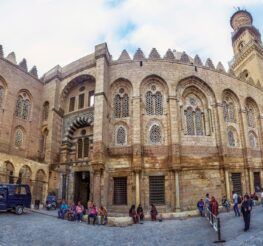-
Mohamed Abdou Street (Off Zeinab Khatoum Home)
-
Museums
-
Melissa Howell

Sharing a
courtyard with Beit El Harrawi and Beit Zeinab El Khatoun, Beit El Sit El Wasila
is another example of Egyptian architecture from the days of yore. Much like
Beit El Suheimi and Beit El Harrawi, Beit El Sit El Wasila now houses a number
of cultural events throughout the year.
Despite
measures to modernise the facility, Beit El Sit El Wasila retains much of its
original charm. So, although there is a room filled with computers off of one
side of the courtyard, a room close by is historically preserved and includes
some beautiful wall paintings of travels and pilgrimages.
A stone
staircase leads to a loggia intimately overlooking the small private courtyard
below. Much of the second floor is blocked off for office use or for other uses
serving the poetry house, but the main elements of Beit El Sit El Wasila have
been respectfully left unchanged. The Ottoman-style hammam is intact with a
dome ceiling spotted with coloured glass, and traditional mashrabeya screens
are seen throughout the house.
The main
attraction of Beit El Sit El Wasila is the large hall on the ground floor. What
was used for receiving guests to this once private residence is now used as a
space for poetry readings. A stage at the far end of the wall and several rows
of chairs fill much of the space in front of it. Separating the two is an old
well that was discovered during a renovation of the house. The well predates
the structure and is considered by some to be the oldest known well in Egypt.
A small
seating area of couches and coffee tables sits on either side of the hall.
All of the furniture currently in Beit El Sit El Wasila was made
especially for the house, including everything in the cosy room just off the
main hall, where a few funky lamps and deep cushioned couches provide a place
for relaxation and conversation.
Established in 1664, Beit El Sit El Wasila is named after the slave of a
late owner of the house. Sit Wasila Bint Abdallah El Beda died in 1835, and for
some time, the house was abandoned. It was discovered some time later
that the house was being used for drug trading; so the Ministry of Culture
assigned the property to be used for the arts and is now known as the House of
Poetry. Poetry readings are frequently held in the grand hall, while
meeting rooms and administration offices have been set up on the second floor.
Should you come across a poetry house employee, they are
likely to be very kind. If you’ve gotten a bit lost– which isn’t
difficult in some of these old house labyrinths– they will happily steer you
in the right direction and probably offer to show you around a bit while
sharing their knowledge about the house. Take them up on this offer: while the
house is truly beautiful, very little information is posted beyond a brief
history and schedule of upcoming events.
Write your review
recommended
 Arts & Culture
Arts & Culture
The Coptic Museum: The History of Egypt to the Tunes of Psalms of David
arts & culture cairo museums +4 Health & Fitness
Health & Fitness
Egyptians in the 2024 Summer Olympics
Egyptians in the Olympics Olympics +1 City Life
City Life
Weekend Guide: Bazar by Sasson, Memo, The Cadillacs, Heya Bazaar, Dou, Nesma Herky & More
Concerts The Weekend Guide +2 Arts & Culture
Arts & Culture

